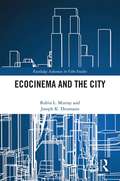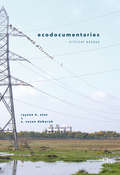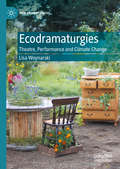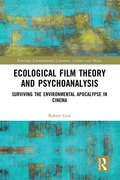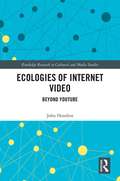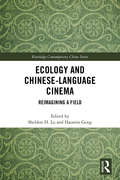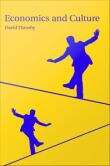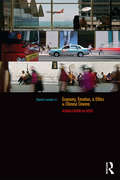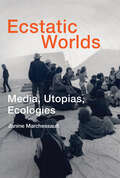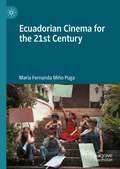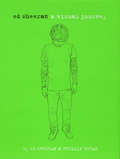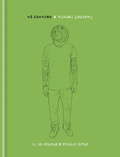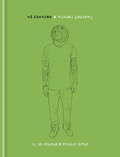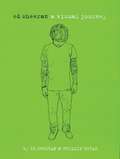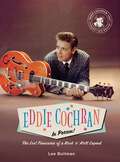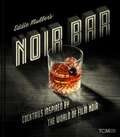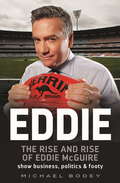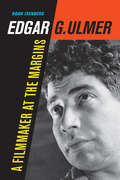- Table View
- List View
Eco Soma: Pain and Joy in Speculative Performance Encounters (Art After Nature)
by Petra KuppersModeling a disability culture perspective on performance practice toward socially just futures In Eco Soma, Petra Kuppers asks readers to be alert to their own embodied responses to art practice and to pay attention to themselves as active participants in a shared sociocultural world. Reading contemporary performance encounters and artful engagements, this book models a disability culture sensitivity to living in a shared world, oriented toward more socially just futures.Eco soma methods mix and merge realities on the edges of lived experience and site-specific performance. Kuppers invites us to become moths, sprout gills, listen to our heart&’s drum, and take starships into crip time. And fantasy is central to these engagements: feeling/sensing monsters, catastrophes, golden lines, heartbeats, injured sharks, dotted salamanders, kissing mammoths, and more. Kuppers illuminates ecopoetic disability culture perspectives, contending that disabled people and their co-conspirators make art to live in a changing world, in contact with feminist, queer, trans, racialized, and Indigenous art projects. By offering new ways to think, frame, and feel &“environments,&” Kuppers focuses on art-based methods of envisioning change and argues that disability can offer imaginative ways toward living well and with agency in change, unrest, and challenge.Traditional somatics teach us how to fine-tune our introspective senses and to open up the world of our own bodies, while eco soma methods extend that attention toward the creative possibilities of the reach between self, others, and the land. Eco Soma proposes an art/life method of sensory tuning to the inside and the outside simultaneously, a method that allows for a wider opening toward ethical cohabitation with human and more-than-human others.
Eco-Performance, Art, and Spatial Justice in the US (Routledge Environmental Humanities)
by Courtney B. RyanIn Eco-Performance, Art, and Spatial Justice in the US, Courtney B. Ryan traces how urban artists in the US from the 1970s until today contend with environmental domestication and spatial injustice through performance. In theater, art, film, and digital media, the artists featured in this book perform everyday, spatialized micro-acts to contest the mutual containment of urbanites and nonhuman nature. Whether it is plant artist Vaughn Bell going for a city stroll in her personal biosphere, photographer Naima Green photographing Black urbanites in lush New York City parks, guerrilla gardeners launching seed bombs into abandoned city lots, or a satirical tweeter parodying BP’s response to the 2010 Deepwater Horizon oil spill, the subjects in this book challenge deeply engrained Western directives to domesticate nonhuman nature. In examining how urban eco-artists perform alternate ecologies that celebrate the interconnectedness of marginalized human, vegetal, and aquatic life, Ryan suggests that small environmental performances can expose spatial injustice and increase spatial mobility. Bringing a performance perspective to the environmental humanities, this interdisciplinary text offers readers stymied by the global climate crisis a way forward. It will appeal to a wide range of students and academics in performance, media studies, urban geography, and environmental studies.
Eco-Trauma Cinema (Routledge Advances in Film Studies)
by Anil NarineFilm has taken a powerful position alongside the global environmental movement, from didactic documentaries to the fantasy pleasures of commercial franchises. This book investigates in particular film’s complex role in representing ecological traumas. Eco-trauma cinema represents the harm we, as humans, inflict upon our natural surroundings, or the injuries we sustain from nature in its unforgiving iterations. The term encompasses both circumstances because these seemingly distinct instances of ecological harm are often related, and even symbiotic: the traumas we perpetuate in an ecosystem through pollution and unsustainable resource management inevitably return to harm us. Contributors to this volume engage with eco-trauma cinema in its three general forms: accounts of people who are traumatized by the natural world, narratives that represent people or social processes which traumatize the environment or its species, and stories that depict the aftermath of ecological catastrophe. The films they examine represent a central challenge of our age: to overcome our disavowal of environmental crises, to reflect on the unsavoury forces reshaping the planet's ecosystems, and to restructure the mechanisms responsible for the state of the earth.
Ecocinema Theory and Practice (AFI Film Readers)
by Sean Cubitt Stephen Rust Salma MonaniEcocinema Theory and Practice is the first collection of its kind—an anthology that offers a comprehensive introduction to the rapidly growing field of eco-film criticism, a branch of critical scholarship that investigates cinema’s intersections with environmental understandings. It references seminal readings through cutting edge research and is designed as an introduction to the field as well as a sourcebook. It defines ecocinema studies, sketches its development over the past twenty years, provides theoretical frameworks for moving forward, and presents eloquent examples of the practice of eco-film criticism through essays written by the field’s leading and emerging scholars. From explicitly environmental films such as Werner Herzong's Grizzly Man and Roland Emmerich's The Day After Tomorrow to less obvious examples like Errol Morris's Fast, Cheap & Out of Control and Christopher Nolan's Inception, the pieces in this collection comprehensively interrogate the breadth of ecocinema. Ecocinema Theory and Practice also directs readers to further study through lists of recommended readings, professional organizations, and relevant periodicals.
Ecocinema in the City (Routledge Advances in Film Studies)
by Robin L. Murray Joseph K. HeumannIn Ecocinema in the City, Murray and Heumann argue that urban ecocinema both reveals and critiques visions of urban environmentalism. The book emphasizes the increasingly transformative power of nature in urban settings, explored in both documentaries and fictional films such as Children Underground, White Dog, Hatari! and Lives Worth Living. The first two sections—"Evolutionary Myths Under the City" and "Urban Eco-trauma"—take more traditional ecocinema approaches and emphasize the city as a dangerous constructed space. The last two sections—"Urban Nature and Interdependence" and "The Sustainable City"—however, bring to life the vibrant relationships between human and nonhuman nature. Ecocinema in the City provides a space to explore these relationships, revealing how ecocinema shows that both human and nonhuman nature can interact sustainably and thrive.
Ecodocumentaries
by Rayson K. Alex S. Susan DeborahThis book features ten critical essays on ecodocumentaries written by eminent scholars from India, USA, Ireland, Finland and Turkey in the area of ecocinema studies. Situating social documentaries with explicit ecological form and content, the volume takes relational positions on political, cultural and conservational aspects of natures and cultures in various cultural contexts. Documentaries themed around issues such as electronic waste, animal rights, land ethics, pollution of river, land grabbing, development and exotic plants are some of the topics ecocritiqued in this volume.
Ecodramaturgies: Theatre, Performance and Climate Change (New Dramaturgies)
by Lisa WoynarskiThis book addresses theatre’s contribution to the way we think about ecology, our relationship to the environment, and what it means to be human in the context of climate change. It offers a detailed study of the ways in which contemporary performance has critiqued and re-imagined everyday ecological relationships, in more just and equitable ways. The broad spectrum of ecologically-oriented theatre and performance included here, largely from the UK, US, Canada, Europe, and Mexico, have problematised, reframed, and upended the pervasive and reductive images of climate change that tend to dominate the ecological imagination. Taking an inclusive approach this book foregrounds marginalised perspectives and the multiple social and political forces that shape climate change and related ecological crises, framing understandings of the earth as home. Recent works by Fevered Sleep, Rimini Protokoll, Violeta Luna, Deke Weaver, Metis Arts, Lucy + Jorge Orta, as well as Indigenous activist movements such as NoDAPL and Idle No More, are described in detail.
Ecological Film Theory and Psychoanalysis: Surviving the Environmental Apocalypse in Cinema (Routledge Environmental Literature, Culture and Media)
by Robert GealThis book applies ecolinguistics and psychoanalysis to explore how films fictionalising environmental disasters provide spectacular warnings against the dangers of environmental apocalypse, while highlighting that even these apparently environmentally friendly films can still facilitate problematic real-world changes in how people treat the environment. Ecological Film Theory and Psychoanalysis argues that these films exploit cinema’s inherent Cartesian grammar to construct texts in which not only small groups of protagonist survivors, but also vicarious spectators, pleasurably transcend the fictionalised destruction. The ideological nature of the ‘lifeboats’ on which these survivors escape, moreover, is accompanied by additional elements that constitute contemporary Cartesian subjectivity, such as class and gender binaries, restored nuclear families, individual as opposed to social responsibilities for disasters, and so on. The book conducts extensive analyses of these processes, before considering alternative forms of filmmaking that might avoid the dangers of this existing form of storytelling. The book’s new ecosophy and film theory establishes that Cartesian subjectivity is an environmentally destructive ‘symptom’ that everyday linguistic activities like watching films reinforce. This book will be of great interest to students and scholars of film studies, literary studies (specifically ecocriticism), cultural studies, ecolinguistics, and ecosophy.
Ecologies of Internet Video: Beyond YouTube (Routledge Research in Cultural and Media Studies)
by John HondrosThis book explores the complex, dynamic, and contested webs of relationships in which three different groups of video makers found themselves when distributing their work on the Internet. It draws upon both the Deleuzian notion of "assemblage" and Actor-Network Theory, which together provide a rich conceptual framework for characterizing and analysing these webs. The groups examined are a UK video activist project, a community of film and television fans originating in the US, and an association of US community television producers. Rather than taking YouTube as its point of departure, this book centres on the groups themselves, contextualizing their contemporary distribution practices within their pre-Internet histories. It then follows the groups as they drew upon various Internet technologies beyond YouTube to create their often-complex video distribution assemblages, a process that entangled them in these webs of relationships. Through the analysis of detailed ethnographic fieldwork conducted across a period of several years, this book demonstrates that while the groups found some success in achieving their various goals as video makers, their situations were often problematic and their agency limited, with their practices contested by both human and technological actors within their distribution assemblages.
Ecology and Chinese-Language Cinema: Reimagining a Field (Routledge Contemporary China Series)
by Sheldon H. Lu Haomin GongThis edited collection explores new developments in the burgeoning field of Chinese ecocinema, examining a variety of works from local productions to global market films, spanning the Maoist era to the present. The ten chapters examine films with ecological significance in mainland China, Hong Kong, and Taiwan, including documentaries, feature films, blockbusters and independent productions. Covering not only well-known works, such as Under the Dome, Wolf Totem, Tie Xi Qu: West of the Tracts, and Mermaid, this book also provides analysis of less well-known but critically important works, such as Anchorage Prohibited, Luzon, and Three Flower/Tri-Color. The unique perspectives this book provides, along with the comprehensive engagement with existing Chinese and English scholarship, not only extend the scope of the growing field of ecocinematic studies, but also seeks to reform the means through which Chinese-language eco-films are understood in the years to come. Ecology and Chinese-Language Ecocinema will be of huge interest to students and scholars in the fields of Chinese cinema, environmental studies, media and communication studies.
Economics and Culture
by David ThrosbyIn an increasingly globalised world, economic and cultural imperatives can be seen as two of the most powerful forces shaping human behaviour. This book considers the relationship between economics and culture both as areas of intellectual discourse, and as systems of societal organisation. Adopting a broad definition of culture, it explores the economic dimensions of culture, and the cultural context of economics. The book is built on a foundation of value theory, developing the twin notions of economic and cultural value as underlying principles for integrating the two fields. Ideas of cultural capital and sustainability are discussed, especially as means of analysing the particular problems of cultural heritage, drawing parallels with the treatment of natural capital in ecological economics. The book goes on to discuss the economics of creativity in the production of cultural goods and services; culture in economic development; the cultural industries; and cultural policy.
Economies of Collaboration in Performance: More than the Sum of the Parts
by Dominic Symonds Karen SavageThis is a book about collaboration in the arts, which explores how working together seems to achieve more than the sum of the parts. It introduces ideas from economics to conceptualize notions of externalities, complementarity, and emergence, and playfully explores collaborative structures such as the swarm, the crowd, the flock, and the network. It uses up-to-date thinking about Wikinomics, Postcapitalism, and Biopolitics, underpinned by ideas from Foucault, Bourriaud, and Hardt and Negri. In a series of thought-provoking case studies, the authors consider creative practices in theatre, music and film. They explore work by artists such as Gob Squad, Eric Whitacre, Dries Verhoeven, Pete Wyer, and Tino Seghal, and encounter both live and online collaborative possibilities in fascinating discussions of Craigslist and crowdfunding at the Edinburgh Festival. What is revealed is that the introduction of Web 2.0 has enabled a new paradigm of artistic practice to emerge, in which participatory encounters, collaboration, and online dialogue become key creative drivers. Written itself as a collaborative project between Karen Savage and Dominic Symonds, this is a strikingly original take on the economics of working together.
Economy, Emotion, and Ethics in Chinese Cinema: Globalization on Speed (Routledge Contemporary China Series)
by David Leiwei LiThe First and Second Comings of capitalism are conceptual shorthands used to capture the radical changes in global geopolitics from the Opium War to the end of the Cold War and beyond. Centring the role of capitalism in the Chinese everyday, the framework can be employed to comprehend contemporary Chinese culture in general and, as in this study, Chinese cinema in particular. This book investigates major Chinese-language films from mainland China, Taiwan, and Hong Kong in order to unpack a hyper-compressed capitalist modernity with distinctive Chinese characteristics. As a dialogue between the film genre as a mediation of microscopic social life, and the narrative of economic development as a macroscopic political abstraction, it engages the two otherwise remotely related worlds, illustrating how the State and the Subject are reconstituted cinematically in late capitalism. A deeply cultural, determinedly historical, and deliberately interdisciplinary study, it approaches "culture" anthropologically, as a way of life emanating from the everyday, and aesthetically, as imaginative forms and creative expressions. Economy, Emotion, and Ethics in Chinese Cinema will appeal to students and scholars of Chinese cinema, cultural studies, Asian studies, and interdisciplinary studies of politics and culture.
Ecstatic Worlds: Media, Utopias, Ecologies (Leonardo)
by Janine MarchessaultWhen media translate the world to the world: twentieth-century utopian projects including Edward Steichen's “Family of Man,” Jacques Cousteau's underwater films, and Buckminster Fuller's geoscope.janine
Ecuadorian Cinema for the 21st Century
by María Fernanda Miño PugaEcuadorian cinema has been largely overlooked in film scholarship, usually being limited to brief descriptions in Latin American compendiums. Ecuadorian cinema for the 21st century would be the first major publication in English to fill this gap. It provides a thorough account of film activities during the new millennium, while also referring to the country’s previous film history. Specifically, this book discusses the so-called ‘mini-boom” in Ecuadorian cinema, and its relation to industry structures, film policy, and the context of Socialism for the 21st century, hence the chosen terminology of “Ecuadorian cinema for the 21st century”. What makes this project distinctive, aside from the originality of its content, is its transdisciplinary methodology. As a means to frame the textual analysis of selected films, this book discusses theories on national cinemas, memory, political ideology, and production practices, in an interdisciplinary approach that can be emulated in later projects. For this purpose, the book is divided into five chapters, in addition to a brief introduction and conclusion. Each chapter relies on specific case studies to discuss local narratives and documentaries, whether state sponsored or privately funded, centring primarily on films that premiered in commercial theatres between 2006 and 2016.
Ed Sheeran: A Visual Journey
by Ed Sheeran Phillip ButahEd Sheeran is the soulful singer-songwriter from England who has captivated American audiences. With words by Ed Sheeran and illustrations by his childhood friend, artist Phillip Butah (who produces artwork for Sheeran’s albums and singles), and accompanying photos, Ed Sheeran: A Visual Journey is an exclusive, fully authorized, first-person account by Ed of how he became an internationally renowned singer-songwriter. In the book, Ed explores his early musical experiences and influences as well as his time recording and touring, right up to the release of his second album, 'x’. The book reveals what drives and inspires Ed as he continues to evolve as an artist, while coping with stratospheric success. With close to 100 photographs and illustrations this is a book that all Ed Sheeran fans would love to own and cherish.
Ed Sheeran: A Visual Journey
by Phillip Butah Ed Sheeran Sheeran)With words by Ed Sheeran and illustrations by his childhood friend, artist Phillip Butah (who produces artwork for Sheeran's albums and singles), and accompanying photos, Ed Sheeran: A Visual Journey is an exclusive, fully authorised, first-person account by Ed of how he became an internationally renowned singer-songwriter.In the book, Ed explores his early musical experiences and influences as well as his time recording and touring, right up to the release of his second album, 'x'. The book reveals what drives and inspires Ed as he continues to evolve as an artist, while coping with stratospheric success, and is an honest account of what it takes to make it in the music business.With Phillip Butah's distinctive portraits of Ed throughout, this is a unique book celebrating a unique musician. It includes Ed's recollections of working tirelessly on the London gig circuit and self-releasing EPs, working hard on finding his sound, signing to Asylum Records and recording his huge hit album, '+', performing at the Grammys, touring with Taylor Swift and sell-out headline gigs at Madison Square Garden. It takes us up to Ed as a musician today, including recording his new album, 'x'.
Ed Sheeran: A Visual Journey
by Phillip Butah Ed Sheeran Sheeran)**This enhanced edition includes behind-the-scenes videos of the making of the book and an exclusive message from Ed.** With words by Ed Sheeran and illustrations by his childhood friend, artist Phillip Butah (who produces artwork for Sheeran's albums and singles), and accompanying photos, Ed Sheeran: A Visual Journey is an exclusive, fully authorised, first-person account by Ed of how he became an internationally renowned singer-songwriter. In the book, Ed explores his early musical experiences and influences as well as his time recording and touring, right up to the release of his second album, 'x'. The book reveals what drives and inspires Ed as he continues to evolve as an artist, while coping with stratospheric success, and is an honest account of what it takes to make it in the music business. With Phillip Butah's distinctive portraits of Ed throughout, this is a unique book celebrating a unique musician. It includes Ed's recollections of working tirelessly on the London gig circuit and self-releasing EPs, working hard on finding his sound, signing to Asylum Records and recording his huge hit album, '+', performing at the Grammys, touring with Taylor Swift and sell-out headline gigs at Madison Square Garden. It takes us up to Ed as a musician today, including recording his new album, 'x'.
Ed Sheeran: A Visual Journey
by Ed Sheeran X Phillip ButahEd Sheeran is the soulful singer-songwriter from England who has captivated American audiences. With words by Ed Sheeran and illustrations by his childhood friend, artist Phillip Butah (who produces artwork for Sheeran’s albums and singles), and accompanying photos, Ed Sheeran: A Visual Journey is an exclusive, fully authorized, first-person account by Ed of how he became an internationally renowned singer-songwriter. In the book, Ed explores his early musical experiences and influences as well as his time recording and touring, right up to the release of his second album, 'x’. The book reveals what drives and inspires Ed as he continues to evolve as an artist, while coping with stratospheric success. With close to 100 photographs and illustrations this is a book that all Ed Sheeran fans would love to own and cherish.
Eddie Cochran: The Lost Treasures of a Rock 'n' Roll Legend
by Lee BullmanIn the golden era of rock 'n' roll, there was one name who rivaled Elvis Presley, both in style and talent: Eddie Cochran. In his short 21 years, Eddie Cochran changed the face of music forever—despite his life being cut tragically cut short when he died in a car crash on his 1960 tour of England. Born in a small town in Minnesota to humble beginnings, Eddie unleashed a wave of raw talent and energy that defied the norms of the era, becoming a trailblazer of the rockabilly sound and look. His smash hits &“Summertime Blues,&” &“C&’mon Everybody,&” and &“Three Steps to Heaven&” are still entertaining audiences and being covered by musicians today, some sixty years after they were first recorded. Cochran&’s guitar style and songwriting not only landed him in the Rock and Roll Hall of Fame, it has influenced nearly every major rock &‘n&’ roll musician, from Paul McCartney and Marc Bolan, to Bruce Springsteen and Joan Jett. Eddie Cochran: In Person! not only details the life and career of a rock 'n' roll icon, it tells the extraordinary story of how a collector came into possession of the contents of Eddie&’s childhood bedroom, which had remained undisturbed and unseen by anyone outside of the Cochran family since his death. Cochran&’s fascinating story, lavishly illustrated with personal mementos, scrapbooks, and even a mockup of his never-released second album, all thought lost for more than sixty years, as well as exquisite performance and portrait photography, paints a picture of what it was like to be a rock &‘n&’ roll superstar on a meteoric rise. NEVER-BEFORE-SEEN COLLECTOR&’S PIECES: All the images and ephemera collected in this book are being published for the first time. ONE OF A KIND: Eddie Cochran: In Person! is the first photographic biography to chronicle the life and times of Eddie Cochran, immortalizing the artist in stunning high-resolution photos and ephemera. BEST-SELLING AUTHOR Lee Bullman (Blowback, Twenty Sixteen) provides expert insight into the life and times of Eddie Cochran, giving an intimate glimpse into the man behind the music.
Eddie Muller's Noir Bar: Cocktails Inspired by the World of Film Noir (Turner Classic Movies)
by Eddie MullerEddie Muller—host of TCM's Noir Alley, one of the world's leading authorities on film noir, and cocktail connoisseur—takes film buffs and drinks enthusiasts alike on a spirited tour through the "dark city" of film noir in this stylish book packed with equal parts great cocktail recipes and noir lore. Eddie Muller's Noir Bar pairs carefully curated classic cocktails and modern noir-inspired libations with behind-the-scenes anecdotes and insights on 50 film noir favorites. Some of the cocktails are drawn directly from the films: If you've seen In a Lonely Place and wondered what&’s in a &“Horse&’s Neck&”—now you&’ll know. If you&’re watching Pickup on South Street you&’ll find out what its director, Sam Fuller, actually drank off-screen. Didn&’t know that Nightmare Alley&’s Joan Blondell inspired a cocktail? It may become a new favorite. Meanwhile, Rita Hayworth is toasted with a "Sailor Beware," an original concoction which, like the film that inspired it (The Lady From Shanghai), is unique, complex, and packs a wallop. Featuring dozens of movie stills, poster art, behind-the-scenes imagery, and stunning cocktail photography, Noir Bar is both a stylish and exciting excursion through classic cinema&’s most popular genre.
Eddie's Friend Boodles
by Carolyn HaywoodA visit to the circus inspires Boodles to experiment with clown makeup and to try to teach his dog Poochie to do tricks.
Eddie: The rise and rise of Eddie McGuire
by Michael BodeyThe inspiring biography of one of Australia's best-known businessmen, TV stars and footy club presidents.Eddie McGuire charts the incredible rise of Edward Joseph McGuire AM from his childhood in the working-class Melbourne suburb of Broadmeadows, through his nightclub days as an ambitious young sports reporter to the heights of television, radio,the AFL and politics.Award-winning author and journalist Michael Bodey explores McGuire's rise to the presidency of the most popular football club in the land, Collingwood; his creation of Channel Nine's 'The Footy Show'; his ascent to become Australian television's 'Eddie Everywhere' before his unlikely appointment as Nine's CEO and 'Five Million Dollar Man'; as well as his political ambitions, including his role opposite Malcolm Turnbull heading the republican campaign.Covering Eddie McGuire's many feuds, his missteps, his successes, the turnaround of his beloved Magpies and his seemingly unstoppable rise, this is the inspiring and unique story of the ultimate working-class boy made good.
Eden Built by Eves: The Culture of Women's Music Festivals
by Bonnie J. MorrisReaders take an exhilarating insider's journey through women's music festivals in the lesbian subculture complete with candid backstage interviews and photographs.
Edgar G. Ulmer: A Filmmaker at the Margins (Weimar and Now: German Cultural Criticism #48)
by Noah IsenbergEdgar G. Ulmer is perhaps best known today for Detour, considered by many to be the epitome of a certain noir style that transcends its B-list origins. But in his lifetime he never achieved the celebrity of his fellow Austrian and German émigré directors—Billy Wilder, Otto Preminger, Fred Zinnemann, and Robert Siodmak. Despite early work with Max Reinhardt and F. W. Murnau, his auspicious debut with Siodmak on their celebrated Weimar classic People on Sunday, and the success of films like Detour and Ruthless, Ulmer spent most of his career as an itinerant filmmaker earning modest paychecks for films that have either been overlooked or forgotten. In this fascinating and well-researched account of a career spent on the margins of Hollywood, Noah Isenberg provides the little-known details of Ulmer’s personal life and a thorough analysis of his wide-ranging, eclectic films—features aimed at minority audiences, horror and sci-fi flicks, genre pictures made in the U.S. and abroad. Isenberg shows that Ulmer’s unconventional path was in many ways more typical than that of his more famous colleagues. As he follows the twists and turns of Ulmer’s fortunes, Isenberg also conveys a new understanding of low-budget filmmaking in the studio era and beyond.




